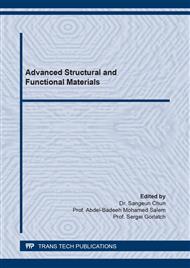[1]
Y. Zhao, X. Sun, P. Cao, Y. Ling, Z. Gao, Q. Zhan, X. Zhou, M. Diao, Mechanical Performance and Numerical Simulation of Basalt Fiber Reinforced Concrete (BFRC) Using Double-K Fracture Model and Virtual Crack Closure Technique (VCCT), Hindawi, Advances in Civil Engineering: l. (2019). Article ID 5630805: 1-13. 2019. httpshttps://doi.org/10.1155/2019/ 5630805.
DOI: 10.1155/2019/5630805
Google Scholar
[2]
K. Krayushkina, T. Khymerik, O. Skrypchenko, I. Moshkovskyi, V. Pershakov, Investigation of Fiber Concrete for Road and Bridge Building, Procedia Engineering, 187 (2017) 620–627.
DOI: 10.1016/j.proeng.2017.04.422
Google Scholar
[3]
M. Saidani, D. Saraireh, M. Gerges, Behaviour of Different Types of Fibre Reinforced Concrete Without Admixture, Engineering Structures, 113 (2016) 328–334.
DOI: 10.1016/j.engstruct.2016.01.041
Google Scholar
[4]
A. Carpinteri, G. Fortese, C. Ronchei, D. Scorza, S. Vantadori, Mode I Fracture Toughness of Fibre Reinforced Concrete, Theoretical and Applied Fracture Mechanics, 91(2017) 66–75.
DOI: 10.1016/j.tafmec.2017.03.015
Google Scholar
[5]
F. Bauer, M. Kempf, F. Weiland, P. Middendorf, Structure-Property Relationships of Basalt Fibers for High Performance Applications, Composites Part B: Engineering, 145 (2018) 121-128.
DOI: 10.1016/j.compositesb.2018.03.028
Google Scholar
[6]
V. Fiore, T. Scalici, G. Di Bella, A. Valenza, A Review on Basalt Fibre and Its Composites, Composites Part B: Engineering, 74 (2015) 74–94.
DOI: 10.1016/j.compositesb.2014.12.034
Google Scholar
[7]
A. Narayanan, P. Shanmugasundaram, Evaluation of Heat Resisting Behaviour of Basalt Fibre Reinforced FG Tiles, Construction and Building Materials, 170 (2018) 679–689.
DOI: 10.1016/j.conbuildmat.2018.03.110
Google Scholar
[8]
X. Sun, Z. Gao, P. Cao, C. Zhou, Y. Ling, X. Wang, Y. Zhao, M. Diao, Fracture Performance and Numerical Simulation of Basalt Fiber Concrete Using Three-Point Bending Test on Notched Beam, Construction and Building Materials, 225 (2019) 788–800.
DOI: 10.1016/j.conbuildmat.2019.07.244
Google Scholar
[9]
X. Sun, Z. Gao, P. Cao, C. Zhou, Mechanical Properties Tests and Multiscale Numerical Simulations for Basalt Fiber Reinforced Concrete, Construction and Building Materials, 202 (2019) 58–72.
DOI: 10.1016/j.conbuildmat.2019.01.018
Google Scholar
[10]
J. Wang, Y. Ma, Y. Zhang, W. Chen, Experimental Research and Analysis on Mechanical Properties of Chopped Basalt Fiber Reinforced Concrete, Engineering Mechanics, 31,No. S (2014) 99–102.
Google Scholar
[11]
S.J. Jin, Z.L. Li, J. Zhang, Y.L. Wang, Experimental Study on Anti-Freezing and Thawing Performance of Reinforced Concrete of Basalt Fiber Under Corrosion Condition, Engineering Mechanics, 32,5 (2015) 178–183.
Google Scholar
[12]
Y. Yu, H. Zhu, X.C. Zhu, Q. Huang, Study on Impact Resistance of Basalt Fiber Reinforced Concrete, Journal of Building Structures, 36,2 (2015) 354–358.
Google Scholar
[13]
J. Branston, S. Das, S.Y. Kenno, C. Taylor, Mechanical Behaviour of Basalt Fibre Reinforced Concrete, Construction and Building Materials, 124 (2016) 878–886.
DOI: 10.1016/j.conbuildmat.2016.08.009
Google Scholar
[14]
C. High, H.M. Seliem, A. El-Safty, S.H. Rizkalla, Use of Basalt Fibers for Concrete Structures, Construction and Building Materials, 96 (2015) 37–46.
DOI: 10.1016/j.conbuildmat.2015.07.138
Google Scholar
[15]
X.Z. Wang, C.X. Li, J.Y. Ling, R.H. Yang, H.L. Xie, Experimental Study on Early Crack of Basalt Fiber Reinforced Concrete, Bulletin of the Chinese Ceramic Society, 36, 11 (2017)3860-3866.
Google Scholar
[16]
A.A. Abbas, Corrigendum to Seismic Response of Steel Fiber Reinforced Concrete Beam-Column Joints, Engineering Structures, 59 (2014) 261-283.
DOI: 10.1016/j.engstruct.2013.10.046
Google Scholar
[17]
F. Luigi, D. Forni, E. Cadoni, Dynamic Behaviour of Cement Mortars Reinforced with Glass and Basalt Fibers. Composites Part B: Engineering, 92 (2016) 142-150.
DOI: 10.1016/j.compositesb.2016.02.035
Google Scholar
[18]
B. Efimov, S. Isachenko, M.B. Kodzoev, G. Dosanova, E. Bobrova, Dispersed Reinforcement in Concrete Technology, E3S Web of Conferences, 110, 0 (2019), SPbWOSCE-2018: 1-8, 2019.https://doi.org/10.1051/e3sconf /201911001032.
DOI: 10.1051/e3sconf/201911001032
Google Scholar
[19]
A.D. Zhukov, A.V. Chugunkov, A.O. Khimich, Cellular concrete for monolithic constructions, Industrial and Civil Construction, 3 (2013) 21–23.
Google Scholar
[20]
V.N. Sokov, A.E. Beglyarov, A.A. Solntsev, A.A. Zhuravleva, A.S. Zhurbin, Integrated Steamhydroinsulating Material, Internet Journal of VolgGASU, 2,33(2014) 1.
Google Scholar
[21]
S.N. Krivoshapko, V.N. Ivanov, Encyclopedia of Analytical Surfaces, Springer, 2015, p.752).
Google Scholar
[22]
Surfaces in Space, The Helicoid http://www.geom.uiuc.edu/zoo/diffgeom/surfspace/helicoid/.
Google Scholar


